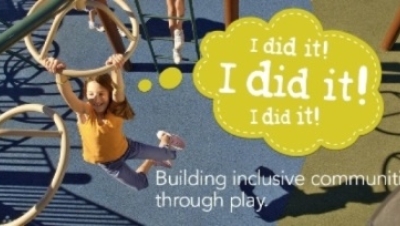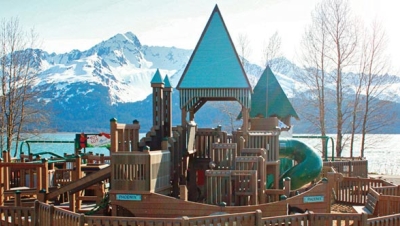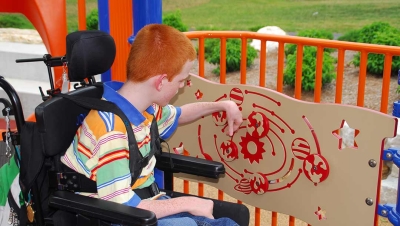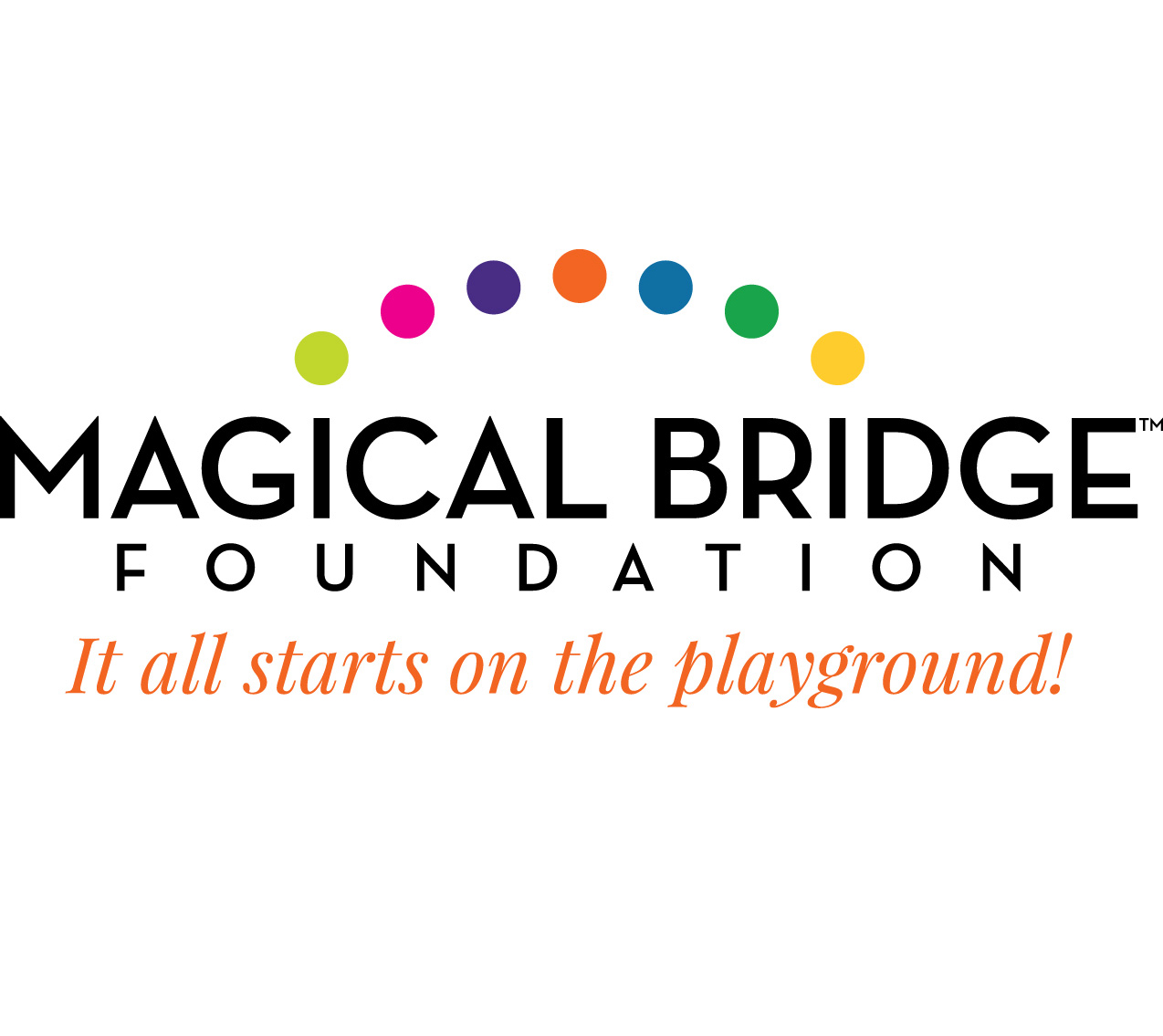Peggy Greenwell has been an accessibility specialist with the US Architectural and Transportation Barriers Compliance Board (Access Board) since November 1992. Her responsibilities include providing technical assistance and training on the Americans with Disabilities Act Accessibility Guidelines (ADAAG) and the Uniform Federal Accessibility Standards (UFAS). She specializes in access issues related to recreation facilities and is coordinating the development of accessibility guidelines for facilities, such as sports facilities, amusement parks, play areas, golf facilities, swimming pools, boating and fishing facilities, and outdoor developed areas. Her work includes responsibility for the coordination of the Board’s recreation rulemaking and has included three federal advisory committees, two of which were regulatory negotiations.
PPM: The vast majority of accessible paths of travel on playgrounds are made with engineered wood fiber (EWF). The level of maintenance needed to ensure that these meet the standard for roll resistance, which most advocates feel is actually the minimum needed for access, seems to be lacking in many, if not most, locations. Is this a concern for you?
PG: Yes. Playground operators and owners need to understand that any surface they choose, including engineered wood fiber, is specifically required by the standards to be “maintained.” The 2010 ADA Accessibility Standards (1008.2.6.1) specifically requires that ground surfaces be “inspected and maintained regularly and frequently to ensure continued compliance with the ASTM F 1951-99” (Standard Specification for Determination of Accessibility of Surface Systems Under and Around Playground Equipment). In addition, regulations implementing the ADA Standards also generally require the “maintenance of accessible features,” including playground surfacing. This requirement applies to all accessible elements and features. For example, where elevators provide access to upper floors in a facility, it is considered a violation if they were continually “out of service.”
I suspect that proper maintenance will be a compliance issue. In 2013, the U.S. Department of Education’s Office for Civil Rights (OCR) received a complaint filed against a Florida school district concerning the accessibility of playground surfaces. The National Center on Accessibility (NCA) at Indiana University reported that:
“According to the OCR resolution letter, the playgrounds were surfaced with wood fiber mulch and the playground owner had provided documentation of the accessibility of the surface system. However, upon visual inspection, OCR reported areas of the ground surface within the play area that were lumped together, uneven, and not smooth for wheelchair access. Further, OCR found that because the ground surface did not appear to be regularly and frequently maintained, they were not in compliance with the 2010 ADA Standards, technical provision 1008.2.6.1.”
Further information is available on NCA’s website - www.ncaonline.org/news/news_doe_playground.shtml
PPM: Peggy, some states, Illinois, California, and New Jersey just to name three, have at times considered prohibiting the use of engineered wood fiber as an accessible playground surface because of the difficulty in maintaining the surface. If properly installed EWF is not maintained, is it an accessible surface?
PG: Any surface, including engineered wood fiber, which is not maintained, will most likely not be compliant over time and meet ASTM F 1951-99 standard. There have also been concerns about the use of “shredded rubber” surfacing. The ADA Standards do not specify which products or materials are compliant or non-compliant. Operators must choose a product that when installed and maintained properly will meet all applicable criteria in the ADA Standards, including referenced ASTM standards.
I’d also like to remind people that the 2010 ADA Standards establish the minimum, not the optimum, necessary for accessibility. It is advisable to exceed the minimum specified in the Standards and provide a higher level of access at play areas and other types of facilities.
PPM: Can you explain what type of maintenance needs to be done with EWF to keep it from getting out of compliance?
PG: I would encourage playground operators and owners to make sure that they understand their responsibilities in complying with the ADA Standards. Purchasing and maintenance decisions will dramatically affect compliance with the standards and potential violations under the ADA when complaints are filed. All surfaces require maintenance to ensure they continue to be accessible and safe.
According to the results of a longitudinal study on playground surfaces sponsored by the Access Board, sites with EWF were found to have the greatest number of deficiencies within 12 months of installation. Some of the deficiencies included excessive running slope, cross slope, and changes in level. There was also concern about the lack of proper installation of all playground surfacing examined in the study. The study, which was conducted by the National Center on Accessibility at Indiana University, is intended to inform playground operators and others responsible for complying with the ADA Standards on how various types of surfaces perform over time. I encourage you to read the report and an accompanying bulletin:
Longitudinal Study of Playground Surfaces to Evaluate Accessibility - www.ncaonline.org/resources/articles/playground-surfacestudy-finalreport.shtml
7 Things Every Playground Owner Should Know about the Accessibility of Their Playground Surfaces - www.access-board.gov/guidelines-and-standards/recreation-facilities/guides/surfacing-the-accessible-playground
PPM: Many in the field believe we need a field test for accessible surfaces, just as we have a field test for impact attenuation. What is the position of the Access Board on a field test for accessibility? How does the testing in a lab differ from real live situations? Why is it important to have the surfacing tested after it is installed?
PG: We agree that there is a need for a field test, especially since there is a requirement for play surfaces to be “inspected regularly and frequently to ensure compliance with ASTM F 1951-99.” This requirement begins right after installation when the playground is open to the public. If you operate or maintain a play area, you need to know when the surface is compliant and when maintenance may be needed. The Rotational Penetrometer is designed to test surfaces in the field and is commercially available. The Board has used this instrument in six surface accessibility research projects undertaken over the past 20 years.
In fact, the Board was involved in the development of this test specifically for this application. Other entities were searching for an objective measurement of what constitutes an “accessible” surface, particularly when it came to playgrounds. The development of the lab test used in ASTM F 1951-99 was initially intended as a “step” toward the development of a field test device known as the “Rotational Penetrometer.”
Field testing is critical for compliance after installation and over time. This is not only true for the accessibility of the surface, but also for its capacity to be impact attenuating according to the referenced ASTM F 1292-04 (Standard Specification for Impact Attenuation of Surfacing Materials within the Use Zone of Playground Equipment). Testing after installation is critical to ensure that the surface remains compliant with both the ASTM F 1951-99 standard for accessibility and the ASTM F 1292-04 standard for impact attenuation.
Our longitudinal study also revealed the need for field testing as opposed to simple “visual” observations. A “loose fill” surface may appear to be compacted enough, but testing will often yield other results. This finding was also noted where installed surfaces were tested for impact attenuation and were found to be out of compliance from either improper installation or settling of the sub-surface.
PPM: We hear that as many as 90% of kids who use mobility devices cannot or will not transfer, effectively making transfer systems unusable. Will we ever see the Access Board recommend ramps in place of transfer systems?
PG: We’ve probably all heard over the years that there may be a higher percentage of children using mobility devices that either do not transfer or choose not to transfer when on a playground. In fact, there are a lot of questions around the issue of “transferring” in general, for both children and adults. To help fill the gap, the Board has been conducting research over the past 6 years in the area of “transfer” and attempting to gain more information about children in particular. To date, we have conducted two small studies related to transfer. In these studies, we examined the height of the surface that users transfer to, space requirements adjacent to the surface, use of grab bars and hand helds, and several other issues. Unfortunately, we were unsuccessful in our attempts to include children in these studies. Both studies involving subject testing to date have only included adults. Clearly, there is a need to learn more about the design criteria established in this area, and we are hopeful that research efforts will continue to expand. The Board is always interested in partnering with other groups to gain more information and expand research efforts.
Access this link for more information on our transfer research projects – www.herl.pitt.edu/ab/
(A final report on the second phase of this study will be available in the summer of 2015.)
PPM: Some in the industry claim that access requirements have reduced the value of playgrounds by making them too easy, too predictable, and too flat. Was that the intent of the Access Board, and do you agree with those characterizations?
PG: I totally disagree with these characterizations. In fact, the Board and the Regulatory Negotiation Committee that helped develop the play area guidelines were committed to ensuring that playgrounds remain fun, exciting, and challenging for all children. There was a concerted effort to avoid prescribing a change in the way play components are designed. Only one provision requires a play component to potentially be designed differently and this is where a seat or entry point is provided. We wanted to make sure that it would be at an appropriate height for a child to transfer from their mobility device. In this case, the requirement only applies to the play component that is required to be accessible. Additionally, the scoping provisions for play areas only apply to a portion of the play components, and ramp access is not required on all play structures.
The accessibility standards do not provide guidance on how to design a play area. That is up to the designers and architects. I’ve seen a tremendous amount of change in the “look” of playgrounds over the last 20 years. I also know that the safety standards have changed as well. While it is true that the accessibility standards require a “minimum” level of accessibility be included in the playground, I really don’t see how they have affected play value.
PPM: What is a play area? We have seen things called playgrounds built to look like treehouses and climbing walls. Are those subject to the 2010 Standards?
PG: A play area is defined in the standards as a “portion of a site containing play components designed and constructed for children.” A climbing wall or a tree house may be considered as “play components” where they are provided within a “play area.” A play component is defined as “an element intended to generate specific opportunities for play, socialization, or learning.”
Sometimes people confuse the play area provisions with those for “areas of sport activity.” The 2010 ADA Standards also requires an accessible route connection to “areas of sport activities.” Not to be confused with play areas, this is “a portion of a room or space where the play or practice of a sport occurs.” This includes (but is not limited to) sports fields, court sports, Frisbee or disc golf, running tracks, and many more.
PPM: Can there be hills and undulating paths in an ADA compliant playground?
PG: Yes, as long as there is at least a minimum of one ground level accessible route that connects accessible play components. This route must comply with the technical provisions contained in 1008.2 of the ADA Standards.
PPM: Peggy, you started at the Access Board 23 years ago. Many view you as the key to all of the recreation regulations, including the play area guidelines. As you look at your time at the Access Board, what are you most proud of?
PG: I think what I’m most proud of is that I was able to “shepherd” this work through the process…sometimes against all odds. But, it was definitely a collective effort. There were many individuals at the Board who worked on this rule, and I feel fortunate to have been a part of the process of establishing accessibility guidelines for play areas, along with all the other recreation facilities. When we first began our work, there was a lot of fear on all sides about how we would accomplish this work. What was accessibility going to look like on a playground? What was it going to cost? The Board needed to learn more about playgrounds. Manufacturers and designers needed to learn about the design needs for children with disabilities and become familiar with existing accessibility standards. People representing children with disabilities needed to learn about some of the impacts of accessibility. Everyone was entering a “new world” and it was not without controversy. I’m proud that we were able to complete the work and see the provisions finally become standards under both the ADA and the Architectural Barriers Act (ABA).
Now, the ADA is celebrating its 25th Anniversary in July 2015 and things are very different! Most importantly, the conversation is different. More people embrace the ADA, even some of those who were in opposition to the ADA and accessibility. There are fewer questions about the rights of children with disabilities to participate in play with their peers. New products and designs are available. Certainty, there is room to improve and innovate and I am hopeful that we will experience even greater positive change in the coming years.
PPM: Peggy, at one point in the rulemaking process the Access Board was criticized and the process was likened to a “smoke-filled back room where bureaucrats would decide what your playground looked like.” Was that fair? How transparent was the process? How much influence did you personally have on the Access Board playground guidelines, now found in the 2010 Standards?
PG: I really don’t know how anyone could say that the Board’s rulemaking process was anything but transparent. Public input was significant throughout the entire process. In developing the play area guidelines, the Board used a regulatory negotiation process. This is a type of collaborative rulemaking process that allows direct input from interested parties and stakeholders in crafting regulations or guidelines by consensus. This type of rulemaking is governed by Federal regulations that ensure fairness, openness, and transparency and affords the public opportunities for comment. The Play Areas Regulatory Negotiation Committee included persons with disabilities, playground operators and designers, play component manufacturers, and others who were responsible for reaching what the provisions should be.
I served as the “Designated Federal Official” (DFO) throughout the work of this committee. It was a great opportunity to work with committee members who were truly “passionate” about playground accessibility. Individuals from different groups represented their “interests” on this committee. The group was joined by an equal number of members from the public who offered regular input throughout the process. The Regulatory Negotiation Committee represented the following groups and associations:
- American Society of Landscape Architects
- ASTM Public Playground Committee
- ASTM Soft Contained Play Committee
- ASTM Playground Surfacing Systems Committee
- International Play Equipment Manufacturers Association
- National Association of Counties
- National Association of Elementary School Principals
- National Child Care Association
- National Council on Independent Living
- National Easter Seal Society
- National League of Cities
- National Parent-Teacher Association
- National Recreation and Park Association
- Spina Bifida Association of America
- TASH
- United Cerebral Palsy Association
- U.S. Access Board
At the end of the day, not all parties (including the Board) had all their interests accepted, but all agreed that they could “live” with them. The committee’s report was the basis of a proposed rule that the Board published and made available for public comment. The Board finalized the play area guidelines according to this public feedback. The entire process was very open and far from a “smoke-filled back room filled with bureaucrats.”
PPM: The ASTM surfacing committee has discussed increasing the fall attenuation standard, however, their recent vote did not pass. How do changes in ASTM standards affect accessible playgrounds?
PG: In order to revise references to an industry standard, the Board must issue a formal rulemaking notice that typically provides an opportunity for public comment. Thus, the Board will need to undertake this process should it seek to revise the edition of the ASTM F 1292 standard referenced by the ADA Standards. Playground owners can always exceed the accessibility standards and utilize a new version as long as it provides for “equivalent or greater access” when engaging in new construction or alteration work. This is covered under the equivalent facilitation provisions (Section 103) of the ADA Standards.
PPM: What are the 3 most important things to consider when choosing a surfacing (beyond price)?
PG:
- Ability of the surface to meet the lab test (ASTM F 1951-99 Standard Specification for Determination of Accessibility of Surface Systems Under and Around Playground Equipment).
- Ability of the surface to meet the impact attenuation standard (ASTM F 1292-04 Standard Specification of Impact Attenuation of Surface Materials within the Use Zone of Playground Equipment), where an accessible surface is provided in a use zone.
- Ability to maintain the surface over time to continually meet all the accessibility and impact attenuating requirements.
PPM: Having observed how the ADA regulations have been manifested on playgrounds over the past 10+ years and looking back on the process, if you had a magic wand and complete freedom to enact any sort of change, is there anything you would do differently?
PG: The only thing that I regret in looking back on the rulemaking process of developing accessibility guidelines for play areas is the length of time that it took to complete them. It was a very long process. Many people do not understand the various, and often time-consuming, steps that must be completed as part of the federal rulemaking process. Each step of the rulemaking process includes checks and balances that, unfortunately, take time. A “regulatory assessment” is required with most rulemaking efforts. This cost benefit analysis typically adds significant time to the Board’s rulemaking agenda. The timing to complete the play area rule was definitely impacted by this requirement.
PPM: When should the public expect to see any revisions to the accessibility standards for play areas from the Access Board?
PG: Revisions to the play area standards are currently not on the Board’s rulemaking agenda. Limited staffing and resources in this small federal agency impact the number of rule making efforts that can be underway at one time. Currently, the Board is at work developing new guidelines or standards for public rights-of-way, passenger vessels, and medical diagnostic equipment and is in the process of updating its ADA guidelines for transportation vehicles. It is difficult to predict when a revision or update of the play area and recreation facilities might occur at this time.













Add new comment